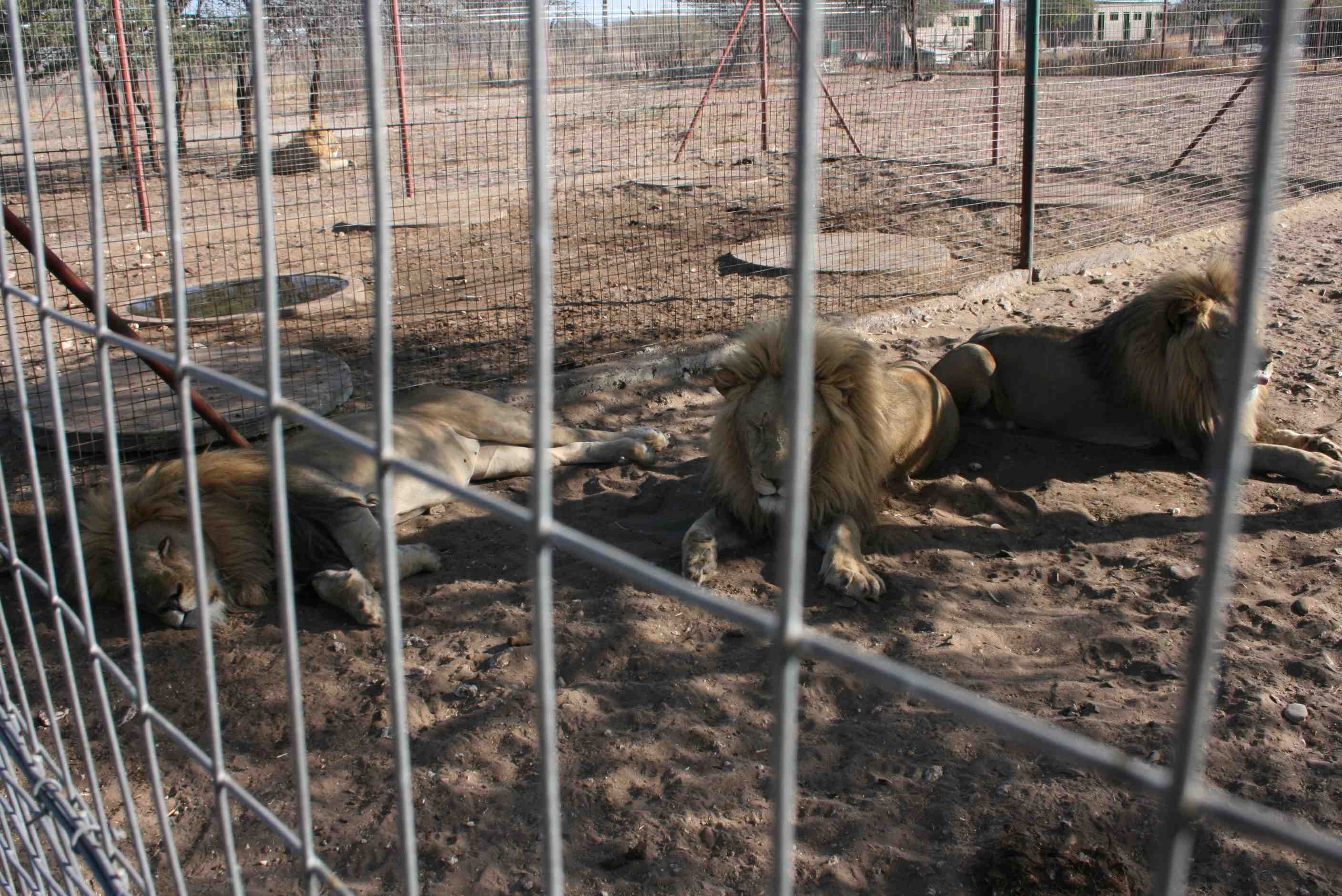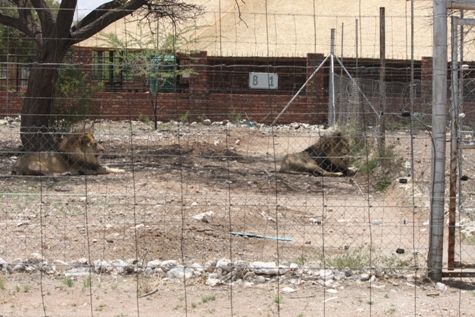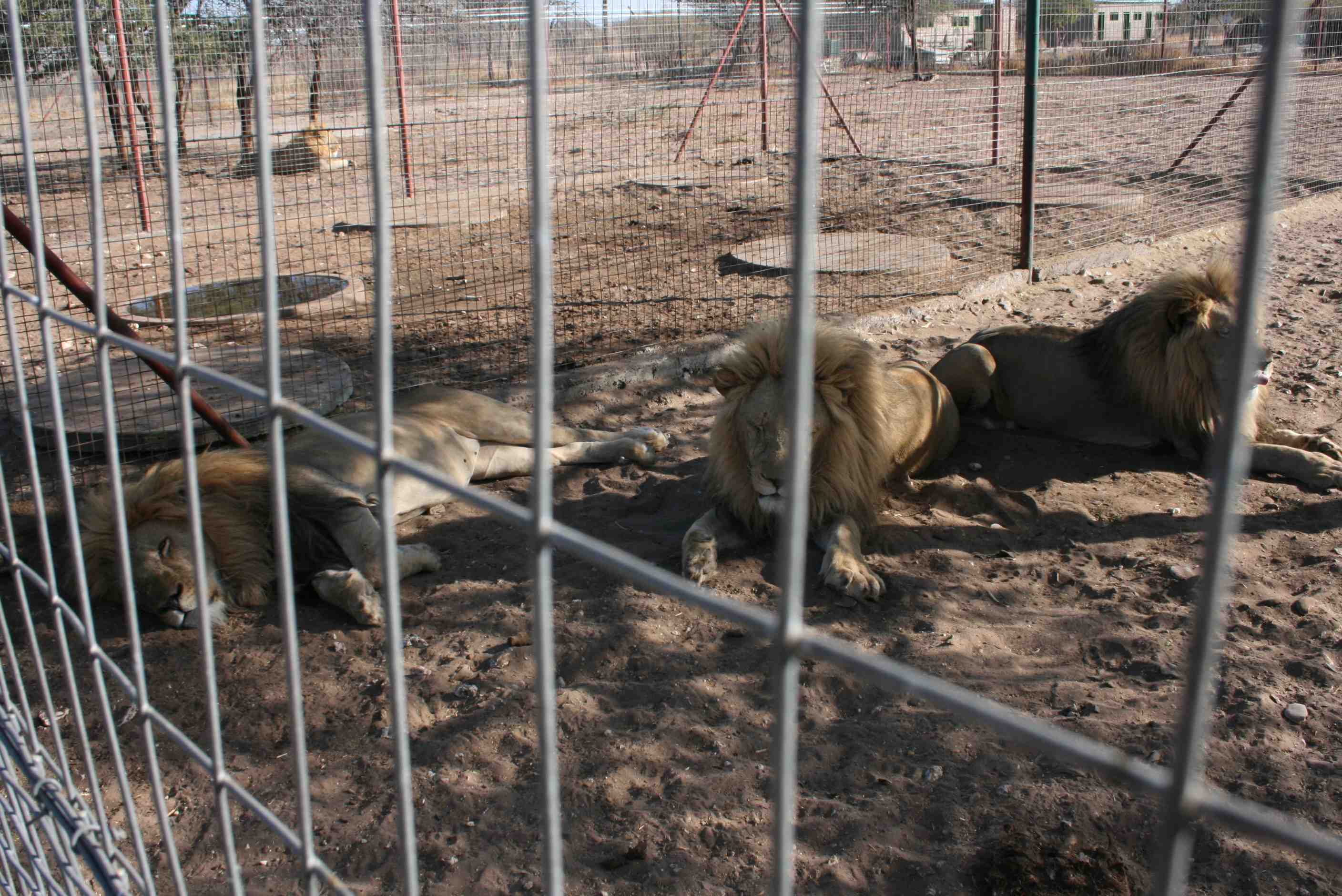
09 Dec Officials turn a blind eye to the smuggling of wild lions
South African farmers are using cattle-rustling routes to smuggle wild lions out of Botswana to supply a growing demand for lion-bone potions in the Far East. Investigation by Fiona Macleod

Two full-maned male lions in a camp at the Makhulu Game Farm near Boshof in the Free State
Conservationists said the illicit trade by organised cartels was adding to the pressures that could see the extinction of big cats in the wild within 10 to 12 years. They denounced Environment Minister Edna Molewa’s response to parliamentary questions that a moratorium on lion-bone exports from South Africa was unnecessary because they do not pose a threat to the survival of the species in the wild.
Dereck Joubert, leader of National Geographic’s Big Cats Initiative, said the lion-bone market was adding to the “emergency situation” facing Africa’s wild lions — the population has crashed from about 200 000 in the 1970s to less than 20 000 today.
“The bone trade out of South Africa is stimulating the market in Asia, which is far bigger than the supply will ever be. Selling lion bones on the market is also putting more pressure on tiger populations and there are fewer than 3 000 of them left in the wild,” he said.
Joubert, who has researched and filmed predators in Botswana for more than 25 years, as well as other conservationists said they noticed that the tempo of lion smuggling across the border had picked up around 2007 when former environment minister Marthinus van Schalkwyk was clamping down on “canned” hunting in South Africa.
Alternative outlets
Captive breeders looking for alternative outlets started setting up business in neighbouring countries and several South Africans were allocated land in communal farming areas in southern Botswana. Some of them also owned farms on the South African side of the border in the Northern Cape.
The smuggling routes they set up around the McCarthy’s Rest border post, about 200km north of Kuruman, are now being used to supply live animals to captive breeding facilities in South Africa, which are making a killing from selling lion bones as a substitute for tiger bones in traditional Asian potions.
Investigators discovered that the farmers used cattle-rustling routes to “launder” the live predators “on an industrial scale” across the border. Often they are cubs taken from lactating females, who are lured out of the Kgalagadi Transfrontier Park to watering points in the arid region and killed.
“Most are caught by a number of specialised capture teams who are supplied with vehicles and other equipment by the buyers in South Africa,” said an investigator who did not want to be named.
Cheetahs, leopards, hyenas and ivory are also part of the cross-border contraband.
The investigator said the trade was being conducted by organised syndicates, which use cellphones and motorcycles to round up livestock and herd them into temporary kraals. Hundreds of cattle will then be loaded on to double-decker trucks using a portable ramp and taken to the border crossing points.
“The two businesses are linked in that, in most cases, the same people who are involved in the theft, smuggling and trading in [mostly stolen] livestock are also involved in the illegal capture, smuggling and trading of predators,” he said.
Details of the smuggling had been supplied to police and conservation officials on both sides of the border, he said. But although a few arrests have been made, there has been little follow-through because local politicians and authorities in both countries are implicated. There is little interest even in stopping the cattle smuggling, which poses a serious threat of foot-and-mouth disease, which could affect beef exports.
Oxpeckers has seen the details and names of the syndicates allegedly involved in the trade, but cannot reveal them without risking the sources. Questions about the trade sent to the department of environmental affairs and Botswana’s department of wildlife and national parks were not answered.
An investigator on the South African side of the border said the cartels were supplying breeders of big cats in North West, Limpopo and the Free State, where most of South Africa’s 200 lion breeders are based.

Official records at the environmental affairs department show there has been a 150% growth in exports of lion products since 2009
Underground
Tales about attempted interventions border on the farcical, including lion cubs being thrown out of vehicle windows when they are being tailed and cheetahs found in car boots.
“There are no permits or paperwork involved in this smuggling business. We even went underground and tracked some evidence as far as China, but nothing was done about it,” the investigator said.
“The government says the captive lion-breeding industry doesn’t affect wild populations, but it does. Asian consumers are prepared to pay more for bones from free-ranging lions because they believe the effects are more potent.”
A complete lion skeleton can sell for up to R80,000. Official records at the environmental affairs department show there has been a 150% growth in exports of lion products since 2009. In 2010, 153 live lions were exported in 2010 as well as 46 lion skins, 235 carcasses, 592 trophies, 43 bodies and 41 skulls.
In May 2012, Molewa said in response to parliamentary questions from the Democratic Alliance that the main export countries were Laos, Vietnam, the United States and Spain. The lion bones exported were “a by-product of the captive-bred lions that are legally hunted”.
A moratorium in terms of national environmental management could be put in place only “if the activity is of a nature that may negatively impact on the survival of the species in the wild. The department does not consider the trade in lion bones as posing [such] a threat,” she said.
Joubert said Botswana’s ecotourism industry attracts the type of visitors who want to see big cats in the wild, not in “zoo situations”.
Botswana’s lion population has recovered to about 3,000 since hunting of the cats was banned in 2007. Most of them are concentrated in the north of the country and there are between 500 and 700 in the south.
“We don’t know how far up the smuggling is happening, but there is evidence it could be reaching as far north as Chobe,” Joubert said.
International trade records released in July 2012 show that South Africa exported 131 live tigers over the past 11 years. Conservationists said the export of 28 live tigers to Botswana was particularly surprising because the near-extinct big cats do not occur naturally in either country.
Pieter Kat, director of LionAid, a conservation organisation based in the United Kingdom, said Botswana had sent back 11 of the 28 tigers, either because they were refused entry or were confiscated by authorities.
“Still, 17 live tigers were exported by South Africa to Botswana and seem to have stayed there. The figures indicate that South African breeders are using Botswana as a laundering point for their wildlife trade.”
There are an estimated 3,000 wild tigers left in the world. The Convention on International Trade in Endangered Species identifies them as near extinction and sets strict conditions for their export and import. Captive-bred tigers are listed under different Cites regulations to wild tigers and only need export permits. Kat said big-cat breeders in South Africa were exploiting this loophole to trade in tigers.
Of the 131 tigers exported between 2000 and 2010, 54 went to the Emirates and 16 to Vietnam. “The Arab Emirates is a well-known staging point for the illegal trade of wildlife from Africa, and any live tiger sent to Vietnam will end up in an Asian traditional medicine pot to be stewed up for some tonic,” Kat said.
“The South African government and the Free State province in particular, where most of the lions are going, are doing the world a disservice by encouraging this lion-bone trade.” – oxpeckers.org, 13 July 2012
